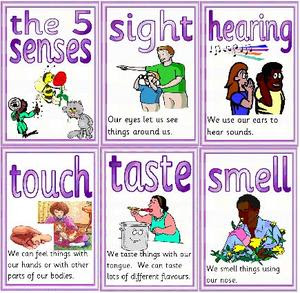Well, every person has senses. Senses are the physiological methods of perception.
There are 5 main senses: touch, smell, taste, sound and sight.

There are 5 secondary senses: balance and acceleration, temperature, kinesthetic (the ability to feel movements of the limbs and body), pain and time. These senses are the only things that create any experience within us whatsoever. The conveyance of any feelings or emotions is through these senses.
Obviously, to give anyone a true brand experience, we’ll have to examine how these senses interplay on a persons psyche and what kind of feelings we can evoke through each sense.
Take taste for instance. What kind of experience does salty food give you vs. sweet foods? What kind of mood does it put you in? What kind of feeling does it leave you with? When do you reach for potato chips, pretzels or popcorn and when do you reach for ice cream? Believe it or not, the major brands for these product categories spend millions of dollars pondering these very questions.
And so it is with all the senses. Are there certain smells that create specific moods or feelings? There wouldn’t be a multibillion dollar fragrance industry if it weren’t so. Are there certain sounds that create specific feelings and moods? Again, there wouldn’t be a multibillion dollar music industry if it weren’t so. Do specific sights create specific moods and feelings? Just look at how much money people spend on ocean view properties.
There is an additional sense though, although its not really a sense, and that is the brain.
Can you visualize things without using your eyes? Sure Just read this excerpt from Eugene Schwartz’s famous book “Breakthrough advertising”: “Colorful, fragrant roses almost as large as the most expensive Hybrid Teas, yet blooming by the hundreds at one single time . . . on one single bush! Cherry-pink 3-inch roses overlaid with tinges of red that deepen in fire and brilliance as the blossoms unfold—to reveal a dazzling gold splash on their petals! Roses that burst into living walls of blossoms that flame again and again into exquisite masses of bloom in June, July, August, September, October, November . . . and often stay in bloom weeks after the first snows have fallen! . . .”
Can you hear without using your ears? Read the headline of the famous Ogilvy Rolls Royce print ad

“At 60 miles per hour, the loudest noise in a Rolls Royce is the ticking of the clock”….. Did you hear a ticking clock?
Can you experience balance and acceleration without moving? Sure, ever watch and IMAX movie?
Can you experience a length of time without it truly passing? Sure ever sit in a Dr’s office doing nothing and waiting to be called. Did it feel like you were waiting forever? Doesn’t time go faster when you’re having fun?
Can you smell something without using your nose? Can you taste something without using your tongue? Can you feel something without it actually touching you? Sure, just watch Ogilvy’s famous Maxwell House coffee commercial Did you feel the steam? Did you smell the coffee? Did you taste the coffee as it was raised to your lips? "If you like to look at good coffee, smell good coffee and taste good coffee, brewed Maxwell House coffee..."
Engaging the senses was the true genius of advertising experts like David Ogilvy and Eugine Schwartz!
The mind is a wondrous thing. It can create experiences and feelings that are purely imaginary. Experiences are life's entertainment. They are what we live and sometimes die for. The question creative agencies have to grapple with is how do we create experiences and feelings within and possibly beyond our audiences senses. Evocation is the key here. What evokes a specific sensation? Master the art of evocation and you'll be on your way to a great career in branding and advertising!
















